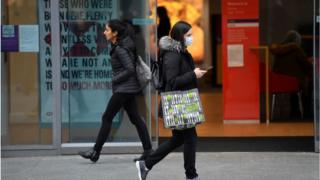Clothing and games push up UK shop prices

Image copyright
Dan Mullan
The UK’s inflation rate rose to 0.6% in June as the coronavirus lockdown began to ease.
The Consumer Prices Index (CPI) picked up slightly from May’s four-year low of 0.5%, the Office for National Statistics (ONS) said.
Food and alcohol prices fell, but prices for clothing and games rose, the ONS said.
Despite the slight increase in the rate, inflation remains below the Bank of England’s 2% target.
Jonathan Athow, deputy national statistician for economic statistics at the ONS, said: “The inflation rate has increased for the first time this year, but remains low by historical standards.
“Due to the impact of the coronavirus, clothing prices have not followed the usual seasonal pattern this year, with the normal falls due to the start of the summer sales failing to materialise.
“Prices for computer games and consoles have risen, but food prices, particularly vegetables, have fallen.”
Inflation has fallen sharply during the coronavirus crisis as consumer demand has slumped.
In June, men’s clothing in particular rose in price, with increases coming “across almost the full range”, the ONS said.
Women’s clothing showed “a more mixed picture across the different products”, but with the overall effect still upward.
Games, toys and hobbies, particularly computer games and computer games consoles, made the biggest contribution to the inflation rise, the ONS said.
“It is possible that prices have been influenced by the coronavirus (Covid-19) lockdown changing the timing of demand and the availability of some items, particularly consoles,” the ONS added.
What is inflation?
Inflation is the rate at which the prices for goods and services increase.
It’s one of the key measures of financial wellbeing because it affects what consumers can buy for their money. If there is inflation, money doesn’t go as far.
It’s expressed as a percentage increase or decrease in prices over time. For example, if the inflation rate for the cost of a litre of petrol is 2% a year, motorists need to spend 2% more at the pump than 12 months earlier.
And if wages don’t keep up with inflation, purchasing power and the standard of living falls.
- What is the inflation rate?
Since many areas of the economy were completely shut down in June, the ONS said it had to estimate or “impute” some of the data.
Jeremy Thomson-Cook, chief economist at financial services firm Equals, said the slight increase in the inflation rate was “a positive sign”, but added that the outlook remained “messy”.
“Food prices are falling from lockdown levels, clothing demand is out of kilter with typical seasonal patterns, demand for entertainment during lockdown provided a pronounced bump in prices, and the ONS has only been able to log 84% of the normal price quotes due to unavailability,” he said.
“For now, however, inflation remains low, and both consumers and the Bank of England will be happy with that.”
Paul Dales, chief UK economist at Capital Economics, said the small rise in inflation was unlikely to be sustained and that deflation was “around the corner”.
“In fact, by July or August, CPI inflation may have fallen below zero,” he said.
Discounting from retailers and the impact of Chancellor Rishi Sunak’s “eat out to help out” scheme would push inflation down, he said.
Mr Dales said any bout of deflation would last just a few months, but added: “It will be a few years before the economy is strong enough to raise inflation to the 2% target.”

